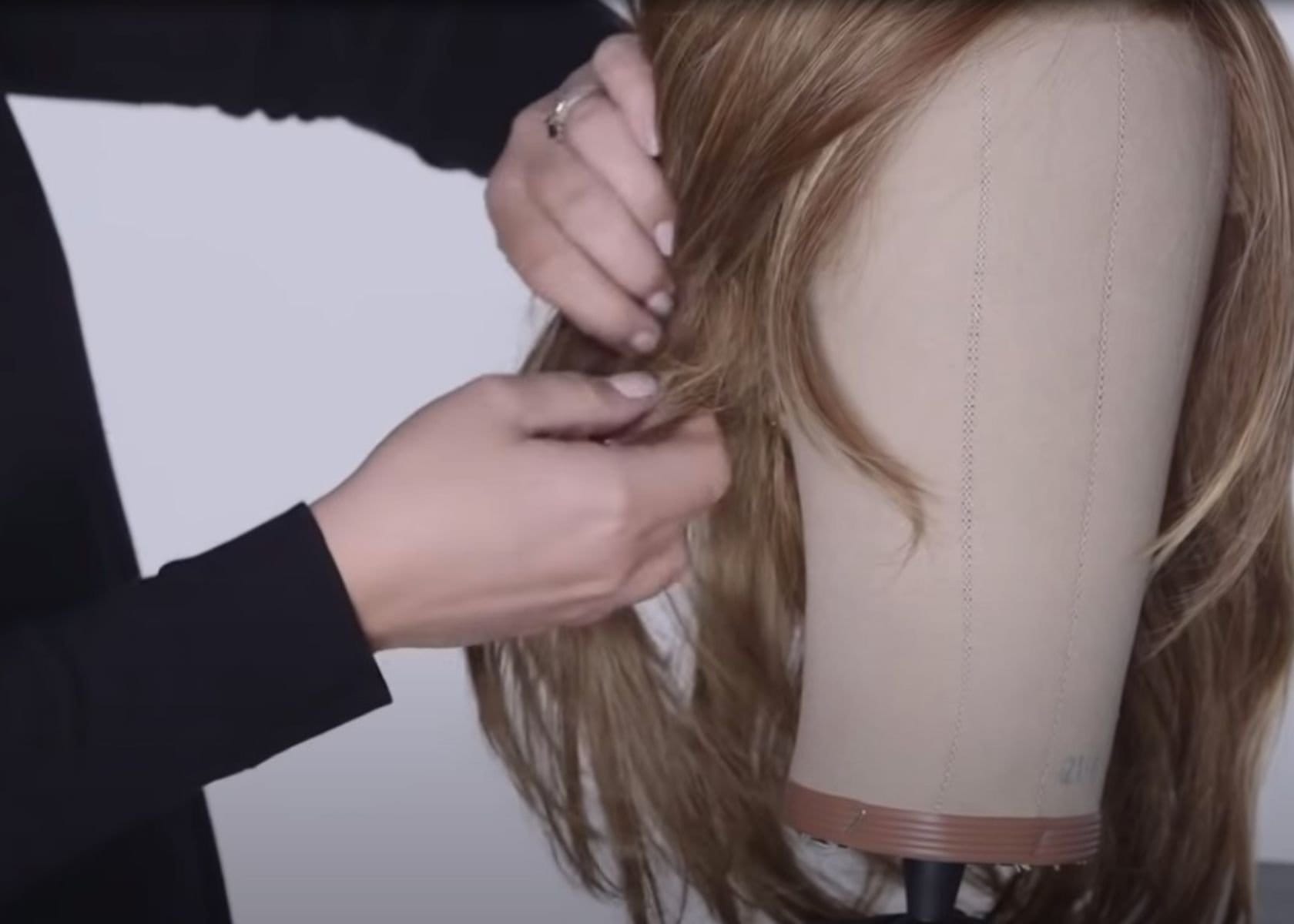Do you have a human hair wig that's turned into a frizzy mess? You're not alone. Lots of people find their favorite hairpieces look more like a fuzzy lion's mane than the sleek style they bought.
But don't worry! Frizz is just a sign your wig needs some extra love and care. One key fact: Human hair wigs get frizzy because they miss out on natural scalp oils that keep hair smooth.
Our blog post has some great tips for getting that wig back to its shiny best. We'll show you how to wash it properly, prevent future fuzziness, and give it the moisture it needs. Say goodbye to frizz and hello to fabulousness with our easy-to-follow advice.
Keep reading; we've got your back –and your wig– covered!
- Regularly wash and condition your human wig hair strands with a sulfate-free, low-pH shampoo and apply a conditioning spray to keep it moisturized and frizz-free.
- Use cool water for washing, deep condition the wig every once in a while, and employ gentle detangling before washing to reduce damage and prevent additional frizz.
- Apply leave-in conditioners or oils specifically formulated for wigs to protect against dryness and smooth out frizzy strands without causing buildup.
- Avoid excessive heat styling by using low heat settings when blowing, drying, and storing the wig properly on a stand or in a satin bag to maintain its shape and texture.
- If you face stubborn frizz issues, consult a professional hair stylist or explore specialized products tailored for human hair wig maintenance.
Understanding Wig Frizziness

Frizziness in wigs can be caused by a variety of factors, including improper care and maintenance. It is important to understand the causes of wig frizz in order to effectively prevent and address it.
Causes of Wig Frizz
Frizz in human hair wigs often stems from a lack of natural moisture and natural hair oils that typically come from the scalp. Unlike our own growing hair, wigs cannot replenish their moisture levels, which can leave them vulnerable to dryness and frizz.
Regular exposure to heat styling tools without adequate protection further strips the wig's strands of moisture, resulting in a frazzled appearance.
Dryness isn't the only culprit; damage also plays a big role. Over time, using harsh products containing sulfates or excessive brushing with inappropriate tools can lead to split ends and a rough texture.
This kind of damage disrupts the wig's cuticle layer, making it more prone to developing frizz. Additionally, low-quality hair used in some wigs is more likely to become frizzy since it doesn't have the resilience found in higher-quality options.
To manage this unruly state, applying products specifically designed for moisturizing human hair wigs can make all the difference. These specially formulated items help smooth out the fibers and add back essential hydration that helps control frizz effectively.
Proper maintenance with gentle detangling using wide-tooth combs and sulfate-free shampooing are key steps toward maintaining sleeker locks on your wig.
Importance of Proper Care and Maintenance
Proper care and maintenance are crucial for preventing and fixing frizziness in human hair wigs. Regular washing with low-pH shampoo and conditioning spray tailored for human hair can restore moisture and manage frizz effectively.
It is important to remember that gentle detangling using a wide-tooth comb or gently brush after washing helps prevent tangling, which can exacerbate frizziness over time. Additionally, using high-quality sulfate-free products specifically designed for human hair wigs can help maintain natural shine and softness while reducing the risk of frizz.
Moreover, proper storage, avoiding excessive styling, and regular deep conditioning treatments are essential for maintaining the quality of human hair wigs. By incorporating these practices into your wig care routine, you can significantly reduce the risk of frizziness and keep your wig looking smooth and vibrant.
Fix a Frizzy Human Hair Wig in Just 2 Steps

Gather supplies such as a wide-tooth comb, low-pH shampoo, and conditioning spray. Detangle the wig gently before washing it with cool water and using a conditioning spray to restore moisture and prevent frizz.
1. Gather Supplies and Detangle
Before fixing a frizzy human hair wig, prepare your supplies and detangle the wig. You will need a wide-tooth comb or paddle brush to gently remove any knots or tangles from the wig.
Additionally, prepare a low-pH shampoo and conditioning spray designed specifically for human hair wigs. Once the supplies are ready, start by carefully detangling the wig from the ends to the roots using gentle strokes with your chosen comb or brush.
As you work through each section of the wig, be mindful of any stubborn tangles and avoid applying excessive force that could cause damage. After thoroughly detangling the wig, you can proceed with washing it using sulfate-free products, as outlined in our previous tips for safely washing your wig.
Remember that proper detangling is essential before washing to prevent further tangling and potential damage during cleaning.
2. Wash with Low-pH Shampoo and Use a Conditioning Spray
Use a gentle, low-pH shampoo to wash the human hair wig. This helps maintain the pH balance of the hair and prevents frizz. After washing, apply a conditioning spray designed for human hair wigs.
This will help moisturize and restore the natural oils of the wig, reducing frizziness.
Proper care is essential when dealing with a frizzy human hair wig. Washing with low-pH shampoo and using a conditioning spray can significantly improve its condition by restoring moisture and preventing further frizz.
Fix a Frizzy Synthetic Wig in 3 Steps

Detangle and wash your synthetic wig with cool water, using fabric softener and heat protectant to restore its smoothness. Blow dry and style with low heat for best results.
1. Detangle and Wash with Cool Water
Gather your supplies, including a wide-tooth comb and sulfate-free shampoo designed for human hair wigs. Begin by gently detangling the wig to remove any knots or tangles, starting from the ends and working your way up to the roots.
Once the wig is detangled, wash it with cool water and a low-pH shampoo, massaging gently to cleanse without causing further frizz. After washing, you can use a conditioning spray specifically formulated for human hair to restore moisture and smoothness.
As you work through this process of detangling and washing with cool water, remember that being gentle is key to maintaining the quality of your human hair wig. Avoid rough handling or aggressive brushing, as this can lead to more frizz rather than less.
2. Use Fabric Softener and Heat Protectant
To fix a frizzy human hair wig, consider using fabric softener and heat protectant. After detangling the wig, wash it with a low-pH shampoo to maintain its natural luster and texture.
Then, apply a conditioning spray to nourish the strands and help combat frizz. When blow-drying the wig, use a low heat setting and a heat protectant to shield the hair from damage. These steps can effectively smooth out the frizziness in your human hair wig while preserving its quality.
Additionally, after washing, you may also want to follow up with an anti-frizz serum or hair oil specifically designed for human hair wigs. This can further manage any remaining frizz while adding shine and moisture back into the strands.
3. Blow Dry and Style with Low Heat
To blow dry and style a frizzy human hair wig with low-heat hair dryers, begin by gently towel drying the wig to remove excess water. Then, apply a heat protectant spray to shield the hair from any potential damage.
Using a wide-tooth comb or paddle brush, detangle the strands while blow-drying on low heat. Once the hair is completely dry, use a serum or oil designed for human hair wigs to add shine and control any remaining frizz.
Remember that excessive heat can further damage and dry out the wig, so using low heat is crucial in maintaining its quality.
3 Ways to Prevent Wig Frizziness

Regular washing and conditioning, use of leave-in conditioners and oils, proper storage, and avoiding excessive styling are essential to prevent wig frizziness. If you want to learn more about how to maintain your wigs and keep them free from frizz, continue reading!
Regular Washing and Conditioning
Regular washing and conditioning are essential to ensure the longevity and smoothness of your human hair wig. Use a sulfate-free shampoo to gently cleanse the wig, followed by a rich conditioner to restore moisture and prevent frizz.
Be sure to detangle the wig using a wide-tooth comb before washing, as this will help minimize tangles during the process. Additionally, opt for a low-pH shampoo that is specifically formulated for human hair wigs to maintain their natural luster without stripping away essential oils.
After washing, apply a conditioning spray designed for human hair wigs to lock in moisture and keep frizz at bay. This step is crucial in maintaining the softness and manageability of your wig.
Use of Leave-In Conditioners and Oils
To tame frizz and nourish human hair wigs, incorporating leave-in conditioners and oils into the maintenance routine is essential. These products provide lasting hydration and protection, helping to combat dryness and prevent frizziness over time.
Look for lightweight leave-in conditioners containing ingredients like argan oil or coconut oil, which can deeply penetrate the wig strands without weighing them down. Additionally, using a small amount of smoothing oil on frizzy areas can help control flyaways and enhance shine without causing buildup.
By applying a dime-sized amount of leave-in conditioner or oil onto the wig after washing and conditioning, you can seal in moisture and maintain smoothness throughout the day. Regular use of these products will not only keep your human hair wig looking healthy but also extend its longevity by reducing breakage and brittleness caused by dryness.
Proper Storage and Avoiding Excessive Styling
Store your human hair wig on a wig stand or in a silk or satin bag to help maintain its shape and prevent tangling. Avoid excessive styling, including heat tools and harsh brushing, as these can lead to frizz and damage the hair fibers.
Additionally, limiting the use of styling products containing alcohol can help prevent dryness and frizziness in your human hair wig.
Regularly reshaping the curls or waves of your human hair wig while it's damp with a diffuser can provide a fresh look without causing excess frizz. Over-brushing and over-styling can strip away natural oils from the hair, so using minimal product and handling it with care during maintenance are essential to keep your wig looking smooth and healthy.
How to Fix a Frizzy Human Hair Wig - FAQs
Human hair wigs can sometimes become overly frizzy and difficult to style. If your human hair wig is looking a bit unruly, don't worry! Many common issues like frizz, tangling, and wrong curl patterns can easily be fixed at home. Read on below for answers to some of the most frequently asked questions about styling and caring for human hair replacement wigs when frizz strikes.
What causes a human hair wig to become frizzy?
Frizz in a human hair wig can be caused by dryness, lack of proper maintenance, and exposure to humidity or heat, affecting the smoothness and styling of the wig.
How do you detangle and manage frizz on a human hair wig?
You can manage frizz and detangle your wig by using special brushed techniques designed for wigs, applying conditioning treatments, and carefully brushing out any knots without causing more static.
Are there specific products that help fix a frizzy human hair wig?
Yes! Look for products specially made for frizzy wig care, like silicone-based serums or oils that offer frizz control as part of your regular human hair wig maintenance routine.
Can I prevent my natural hair wig from getting frizzy in the first place?
Definitely! Preventing frizz includes using gentle brushing methods with appropriate tools when managing your natural hair wigs while also implementing conditioning tips to keep it hydrated and reduce static.
Conclusion
We have discussed effective methods for fixing a frizzy human hair wig. These practical strategies are easy to implement and offer efficient solutions. By applying these tips, you can significantly improve the condition of your wig and achieve smoother, more manageable hair.
For further guidance on caring for your human hair wig, consider consulting with a professional stylist or exploring specialized products designed for wig maintenance.
Remember that taking care of your human hair wig is crucial to maintaining its quality and appearance over time.
If you are using some other methods to fix your frizzy wigs, feel free to share with us in the comments below!
Read More About Caring for Human Hair Wigs





